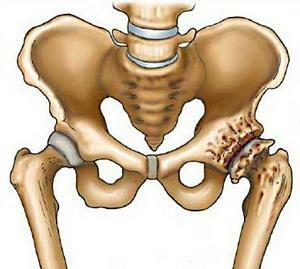 Hip joint osteoarthritis( TZB) is a destructive process that affects the cartilaginous plastics located inside the joint.
Hip joint osteoarthritis( TZB) is a destructive process that affects the cartilaginous plastics located inside the joint.
On the ends of the articular bones is the cartilage, which provides a normal mobility of the limb. With its help, the bones can slide. But gradually the cartilage loses its ability to retain the fluid that is required for movement, and eventually cracks.
The friction of bones begins with each other, the appearance of certain outgrowths of osteophytes that cause pain and other symptoms of the onset of the disease.
The risk of osteoarthritis of the hip arises in people after 45 years. Women are more susceptible, which is explained by changes in the body during menopause, when as a result of hormonal changes calcium is lost.
It accumulates in the cartilage, rendering them destructive. When the bone is broken, surgical intervention becomes necessary, when the damaged bone is replaced with a prosthesis.
Contents of the article
- Provoking factors
- Clinical picture - from discomfort to disability
- Stages of development of pathology
- Diagnostic studies
- Treatment methods conservative and surgical
- Medical treatment
- Comprehensive approach
- Operative intervention
- What do folk healers offer?
- Warn and stop!
Aggravating factors
The main factors of the development of the violation are:
- retirement age;
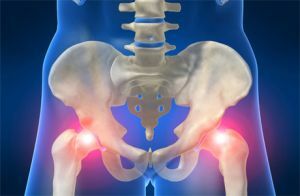
- injuries, long occupations of some sports( weightlifting and jumping);
- excess weight, violation of posture;
- genetic inheritance;
- sex, hormonal disorders;
- some diseases( arthritis, psoriasis);
- severity and work activity, - there are occupations that create the risk of illness( retail, construction, agriculture);
- sedentary image.
Clinical picture - from discomfort to disability
At the initial stage of the development of the disease, the symptoms of osteoarthrosis of the hip joint are slow, with time, exacerbated.
The main manifestations include pain sensations during or after movement, stiffness of joints and loss of flexibility.
Stages of development of pathology
There are three degrees of development of osteoarthrosis of the hip joint, each of which has its own characteristics and symptoms:
- The first stage of destruction is occasionally manifested by pain after physical exertion( prolonged running, walking).Pain sensations are localized in the area of the affected joint, but can extend to the knee joint and thigh. The pain decreases after rest, but the amplitude of movements, gait and muscle strength do not decrease. With x-ray analysis, small bone growths that do not exceed the boundaries of the joint lip are determined. However, the head with the neck of the bone remains unchanged.
- The second degree of is characterized by increased pain that passes to the thigh and inguinal zone,
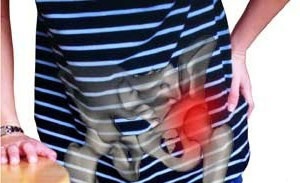 can appear even during rest. Lameness manifests itself as a result of physical activity and a long walk. In this case, there is no normal functioning of the joint, movements are limited, and muscles, extending and withdrawing the hips, are weakened. According to the results of X-ray analysis, bone growths that extend beyond the margins of the cartilaginous lip are revealed on the outer and inner margins of the acetabulum. Also the bone head is deformed, increasing in size and acquiring uneven contours. Cysts can appear in affected structures.
can appear even during rest. Lameness manifests itself as a result of physical activity and a long walk. In this case, there is no normal functioning of the joint, movements are limited, and muscles, extending and withdrawing the hips, are weakened. According to the results of X-ray analysis, bone growths that extend beyond the margins of the cartilaginous lip are revealed on the outer and inner margins of the acetabulum. Also the bone head is deformed, increasing in size and acquiring uneven contours. Cysts can appear in affected structures. - On the third last stage of the pathology, there are constant pains that do not stop even at night. Also, joint movements are limited, atrophy of the lower leg, thigh and buttocks occurs. The injured limb is shortened, when moving, the patient needs to step on the fingers, tilt the body to reach the floor. However, this shifts the center of gravity, and there are increased stresses on the joint. According to the X-ray study, large-scale osseous growths are observed on the swollen cavity and the head of the bone, the extension of the cervix.
Diagnostic studies of
Initial signs of pathology, reflected by systematic joint stiffness, should alert the patient. And with prolonged  manifestations of painful sensations, one must always consult an orthopedist or rheumatologist.
manifestations of painful sensations, one must always consult an orthopedist or rheumatologist.
A specialist can identify the presence of osteoarthritis in the hip joint. The patient should describe in detail about the symptoms, specify the frequency and duration.
To determine the pain threshold, the doctor can rotate, bend and straighten the legs. To assess the external shape of the joint, the patient should walk or stand on his leg.
To determine the appropriate treatment, ultrasound, radiography and a blood test are performed. The study is conducted for the two hip joints to identify the actual pathologies in the joint slits. According to the information received, a specialist can accurately determine the stage of the disease.
Treatment methods conservative and surgical
Osteoarthrosis of the hip joint 1 and 2 degree can be cured with the help of conservative techniques. First you need to remove the inflammation, using medications to relieve pain and increase blood circulation. The category of such products include warming ointments, vitamins and analgesics.
It is also necessary to undergo physiotherapy in the form of magnetotherapy and( or) ultrasound. Traditional treatment can be supplemented with folk methods and means( herbal preparations, rubbers).
Medical treatment
For the treatment of pain, non-narcotic analgesics and non-steroid substances( Indomethacin, Diclofenac, Meloxicam,  Ibuprofen) can be used in the form of rectal suppositories, ointments, tablets and injections.
Ibuprofen) can be used in the form of rectal suppositories, ointments, tablets and injections.
Duration of treatment is determined by symptoms. In the form of injections, hormonal agents( Dexazon, Kenalog) can be recommended to facilitate the patient's condition and movement.
To improve microcirculation in the affected area, anticoagulants and antiaggregants are prescribed( Kurantil or Dipiridamol, Lyoton).
The cartilage structure is improved by chondroprotectors( Aflutop, Teraflex).Such drugs are the main ones in the treatment of osteoarthritis, since they are capable of restoring cartilaginous tissue.
An effective action is the combination of chondroitin sulfate with glucosamine prescribed for 6 months. It is recommended to use an anesthetic compresses on the basis of Dimexide, applied to the affected area within 12-15 days.
In treatment, care should be taken to rest the affected limb, eliminate and remove the underlying symptoms.
Integrated approach to
Also in the treatment of the disease, the following methods and approaches are used:
- Physiotherapy .After restoration of mobility of a joint physiotherapeutic procedures, electrophoresis are appointed. A good
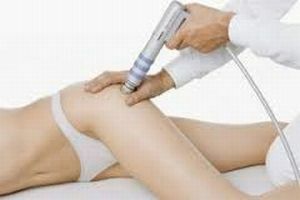 effect has massage and laser treatment. In the future it will be recommended to visit the pool.
effect has massage and laser treatment. In the future it will be recommended to visit the pool. - Diet .During treatment, you must adhere to a special diet based on the exclusion from the diet of sweet, fatty and meat products. Be sure to eat vegetables, fruits, fish, sour-milk products and black bread. It is necessary to add onions, garlic and products with trace elements. But it is desirable to exclude egg yolk, black pepper, potatoes and tomatoes, because they contain solanine, which increases pain.
- Hirudotherapy .Leeches allow you to ease the symptoms of the disease.
- Therapeutic gymnastics .Such procedures can stop muscle atrophy. These include circular rotation in the joint, extension and flexion, bicycle riding. Sometimes specialists prescribe the extension of the patient joint, held in a hospital. In this case, the patient should move on crutches, reducing the load of the joint. Underwater or classical massage is added to the complex.
Operative intervention
Operative intervention is used for osteoarthritis of the hip joint of the third degree, with strong deformities of the joint with 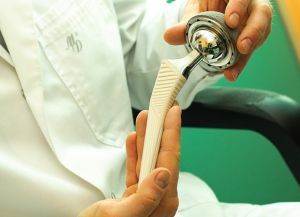 lack of the possibility of normal movements.
lack of the possibility of normal movements.
After completion of the main treatment, the patient must perform additional procedures. So, the achieved result can be fixed LFK, self-massage of muscles of a femur and buttocks, swimming.
At the last stage of osteoarthrosis of TZB with an impossible restoration of cartilage tissues there is one alternative - surgery with joint replacement. But its carrying out differs complexity.
The main complication is a fracture in the neck of the thigh, which is hard and long recovered. In this case, the cartilage loses its amortization parameters, while moving, the load on the thigh increases.
What do folk healers offer?
Traditional medicine that is used to treat osteoarthrosis of the hip joint:
- You can take vegetable oil, honey and mustard on a tablespoon, mix and put in enameled dishes. The mixture is brought to a boil, cooled and filtered. The composition should be applied as a compress, hold it for 2 hours and repeat the next day.
- To reduce the pain, can be mixed with castor oil( 2 tablespoons) with turpentine ( 1 tablespoon), which is rubbed on the patient's joint before going to bed or in the evening for 1-2 weeks.
- Do herbal collection from the leaves of birch and nettles, calendula and elderberry flowers, juniper berries, buckthorn and willow bark, field horsetail in equal amounts. Then take 2 tbsp.l.composition and brewed in a liter of boiling water, boiled and 10 minutes drowned under the lid. The collection should be taken 3-4 cups a day for half an hour before meals, for 3-4 months and a month rest.
Warn and stop!
If there is arthrosis of the joints, do not stay in a sitting position for a long time, because of this the blood supply to the  is reduced to the affected bones. Do not squat, jump and run a lot. It should be alternating loads with rest, when it is desirable to lie down or sit with elongated legs, without pressing or folding them.
is reduced to the affected bones. Do not squat, jump and run a lot. It should be alternating loads with rest, when it is desirable to lie down or sit with elongated legs, without pressing or folding them.
For osteoarthritis, it is advisable to exercise at a moderate pace, swimming is recommended, where the joints do not work, and only the muscles are involved. You can also ride a bicycle on level surfaces, go walking, jogging and skiing.
To preventive measures include the right choice of shoes, which should be comfortable, soft with a small heel up to 2-3 cm Doctors recommend using elastic fasteners, which are selected individually.



